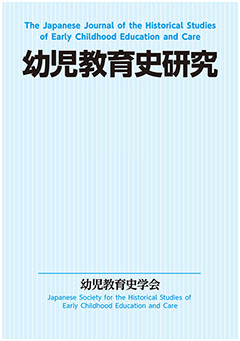9 巻
選択された号の論文の22件中1~22を表示しています
- |<
- <
- 1
- >
- >|
表紙, 目次
-
原稿種別: 表紙
2014 年 9 巻 p. Cover1-
発行日: 2014/10/31
公開日: 2018/03/27
PDF形式でダウンロード (20314K) -
原稿種別: 表紙
2014 年 9 巻 p. Cover2-
発行日: 2014/10/31
公開日: 2018/03/27
PDF形式でダウンロード (20314K)
研究論文
-
原稿種別: 本文
2014 年 9 巻 p. 1-16
発行日: 2014/10/31
公開日: 2018/03/27
PDF形式でダウンロード (1485K) -
原稿種別: 本文
2014 年 9 巻 p. 17-31
発行日: 2014/10/31
公開日: 2018/03/27
PDF形式でダウンロード (3986K)
研究ノート
-
原稿種別: 本文
2014 年 9 巻 p. 33-48
発行日: 2014/10/31
公開日: 2018/03/27
PDF形式でダウンロード (1299K)
シンポジウム記録(第9回大会)
-
原稿種別: 本文
2014 年 9 巻 p. 49-50
発行日: 2014/10/31
公開日: 2018/03/27
PDF形式でダウンロード (149K) -
原稿種別: 本文
2014 年 9 巻 p. 51-66
発行日: 2014/10/31
公開日: 2018/03/27
PDF形式でダウンロード (1572K) -
原稿種別: 本文
2014 年 9 巻 p. 67-75
発行日: 2014/10/31
公開日: 2018/03/27
PDF形式でダウンロード (734K) -
原稿種別: 本文
2014 年 9 巻 p. 77-91
発行日: 2014/10/31
公開日: 2018/03/27
PDF形式でダウンロード (1933K) -
原稿種別: 本文
2014 年 9 巻 p. 93-97
発行日: 2014/10/31
公開日: 2018/03/27
PDF形式でダウンロード (481K)
書評
-
原稿種別: 本文
2014 年 9 巻 p. 99-102
発行日: 2014/10/31
公開日: 2018/03/27
PDF形式でダウンロード (469K) -
原稿種別: 本文
2014 年 9 巻 p. 103-105
発行日: 2014/10/31
公開日: 2018/03/27
PDF形式でダウンロード (372K) -
原稿種別: 本文
2014 年 9 巻 p. 107-110
発行日: 2014/10/31
公開日: 2018/03/27
PDF形式でダウンロード (485K) -
原稿種別: Article
2014 年 9 巻 p. 111-114
発行日: 2014/10/31
公開日: 2018/03/27
PDF形式でダウンロード (497K)
図書紹介
-
原稿種別: 本文
2014 年 9 巻 p. 115-117
発行日: 2014/10/31
公開日: 2018/03/27
PDF形式でダウンロード (332K)
幼児教育史学会会則, 機関誌編集規程, 投稿要領, 論文審査手続き
-
原稿種別: 付録等
2014 年 9 巻 p. 119-120
発行日: 2014/10/31
公開日: 2018/03/27
PDF形式でダウンロード (94K) -
原稿種別: 付録等
2014 年 9 巻 p. 121-
発行日: 2014/10/31
公開日: 2018/03/27
PDF形式でダウンロード (68K) -
原稿種別: 付録等
2014 年 9 巻 p. 122-
発行日: 2014/10/31
公開日: 2018/03/27
PDF形式でダウンロード (31K)
編集後記、機関誌編集委員会, 奥付, その他お知らせ
-
原稿種別: 付録等
2014 年 9 巻 p. 123-
発行日: 2014/10/31
公開日: 2018/03/27
PDF形式でダウンロード (53K) -
原稿種別: 付録等
2014 年 9 巻 p. App1-
発行日: 2014/10/31
公開日: 2018/03/27
PDF形式でダウンロード (28K)
裏表紙, CONTENTS
-
原稿種別: 表紙
2014 年 9 巻 p. Cover3-
発行日: 2014/10/31
公開日: 2018/03/27
PDF形式でダウンロード (46K) -
原稿種別: 表紙
2014 年 9 巻 p. Cover4-
発行日: 2014/10/31
公開日: 2018/03/27
PDF形式でダウンロード (46K)
- |<
- <
- 1
- >
- >|
